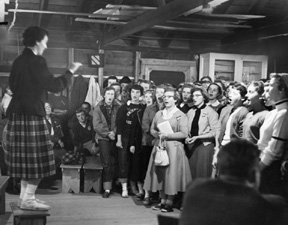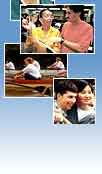

The Review welcomes letters from readers and will print as many of
them as space permits. Letters may be edited for brevity and clarity. Unsigned
letters cannot be used, but names of the writers may be withheld on request.
Letters
Class of '58: That's Us!
 Regarding
the letter, "Frosh Camp Relived" (Spring-Summer 2002), I see an entirely
different group than Ms. Sisson does! Regarding
the letter, "Frosh Camp Relived" (Spring-Summer 2002), I see an entirely
different group than Ms. Sisson does!
I think the photo was taken in the fall of '54. The '56 girls were "Big
Sisters" to the girls of '58, and only junior and freshman girls attended
this weekend camp.
In the picture, the conductor is Pat Weil '56, music major. I think Sarah (Sally)
Vandyck is the girl in front with the purse. Proceeding to the right is June
Fundin, Ann Westburg, and Barbara Bowman. To the far left, standing, is Roberta
(Bobbie) Busky . . . all Class of '58.
Could it be we all looked alike back then?
Barbara Willsea Harper '58
Ruther Glen, Virginia
On page 3 of Rochester Review (Spring- Summer 2002) you have a photo
which one of your readers thought was the Frosh Camp Class of 1952. I checked
with John Rathbone '58, and we both agree that the photo is of Frosh Camp Class
of 1958. Roberta Busky, Carol Garomon, Mary Robinson, Sarah Vandyck, and Ann
Westberg, just to name a few in the front row, would probably agree with me.
Nancy Festa Brown '58
Media, Pennsylvania
The correspondence prompted by the photograph of Frosh Camp sent us back
to the archives, where University librarians again retrieved the photo for us
along with a newspaper clipping in which it appeared.
Sorry to have to take sides in a lively debate, but the clipping is dated
September 25, 1954, and the caption reads: "College Sing: While their 'big
sisters,' the juniors, wash the dishes, the freshmen assemble in the dining
hall after supper to learn the college songs they will be singing many times
during their next four years at the University. Leading the singing (left) is
Pat Weil."
Thanks to everyone for sending along their memories-Editor.
Beautiful for Whom?
I suppose it should come as no surprise that a professor of economics included
an apologia for traditional market economics in a review of A Beautiful Mind
(Spring- Summer 2002).
Steven Landsburg's statement that "Modern economics demonstrates the robust
power of markets to deliver optimum outcomes in a rich array of environments"
begs two crucial questions. First, optimum for whom? Clearly not the millions
of people whose lives are worsened by current market functioning. Second, optimum
by what criteria?
The Invisible Hand so admired by Landsburg has never been able to prevent exploitation
of workers and the environment-or even shareholders-as is increasingly evident.
Some economists are trying hard to measure these "externalities";
others prefer to ignore them.
Norm Wallen '50, '52 (Mas)
Flagstaff, Arizona
Bravo, Wind Ensemble!
Hats off to the Eastman Wind Ensemble and its ebullient founder ("Golden
Harmony," Spring-Summer 2002). I was sorry to hear that Dr. [Frederick]
Fennell is suffering health problems. I came to the University (the College,
not Eastman) in 1943 at the height of WWII carrying with me a French horn and
a letter from my high school band director introducing me to Howard Hanson.
He bucked me to Fennell who was, no doubt, happy to find any warm body who
could play an instrument, and he offered me a place in the symphonic band.
I played under his baton for that freshman year until the draft snagged me,
too. Although I never returned to serious horn study, that year of "playing
with the big boys" was a thrill never forgotten.
Godspeed, Dr. Fred!
Jerome Nolan '49, '52M (MD)
Wilmington, North Carolina
Thank you very much for the article about the Eastman Wind Ensemble.
Although I was never a member of that group, I was in the Eastman Band during
the school year 1951-52, and it was probably the best band I ever played in.
Dr. Fennell did a grand job as conductor of the band and obviously did a fine
job with the Eastman Wind Ensemble.
I would like to gently point out that without the fine material present in
the band at that time, the wind ensemble could never have been formed. Members
of that group have gone on to become the leaders in musical organizations all
over the United States.
John R. Schactler '52E (Mas)
Yakima, Washington
Fundamental Debate
The exchange between Mssrs. Taback and Homerin ("Letters to the Editor,"
Spring-Summer 2002) sent me to Homerin's larger essay referred to in the Winter
2002 issue. I looked in vain for statements that would justify Homerin's comment
that " . . . I am outspoken in my condemnation of religious militants of
all kinds."
In an essay of over 200 lines of type he devotes one-half line to how the militants
should be treated: " . . . the murderers must be brought to justice."
This line refers only to the September 11, 2001, murderers; there is no mention
of murderers of Colombians, Somalis, or Israelis, among others. The thrust of
the essay details the beauty and wisdom of the Koran (Qur'ân) and its
corruption by the Islamic militants.
Does Homerin deplore this corruption and the resultant murderous acts inspired
by this corruption? No, he wants us to understand how and why the militants
justify and are able to inspire wholesale slaughter of human beings. Homerin
argues that the militants' success is due to the poverty and worldwide oppression
of many Muslims; conditions America failed to prevent. "No wonder many
Muslims hate America; we are seeing the hate that neglect produced." "
. . . we as people-all of us-dehumanize other people for our own selfish desires."
The understanding Homerin espouses is that militant Muslim terrorism and slaughter
of U.S. citizens is really our own fault. This does not constitute overt endorsement
of such acts, but it certainly is an apologist's defense.
Is there a Muslim-dominated country in the world that would provide such a
comfortable and prestigious platform for one whose views were so damning to
it? No, but the United States does, and that is its strength. We will survive
all the Homerins because we tolerate disparagement, but we won't tolerate terrorist
acts of murder.
Selwyn W. Becker '52
Professor Emeritus of Psychology
The University of Chicago
In regards to Harold Taback's letter about Emil Homerin's essay in the Winter
2002 issue: One of the things I have always treasured from my four years at
Rochester is the respect I learned for tolerance and understanding. Both have
helped in my career as a company officer and vice president and then as a large
corporation's staff director.
Although these roles were far from religious, the basics still applied: Address
the root issues to solve the problem and thus help all get on with the job and
work together. It's not always the easy road (as I found out many times). People
protect their turf and beliefs (even though they may be wrong!).
I followed Homerin's advice and brought up the essay from the University's
Web site. A very comprehensive discussion. I did not find it the least bit apologistic
about Muslim militants or the principles of Islam.
He is 100 percent right. We need to address the fundamental needs of the world's
needy, and we can do it if we put are minds to it! I say needy in the broad
sense: poverty, lack of food, lack of education. Steps to address and begin
to cure these will pay immense dividends and only expand the growth for everyone.
We do need to bring the perpetrators and participants of September 11 to justice
fairly and quickly (let's hope there are no further major horrors), and get
the Palestinian-Israeli conflict turned around, but we also need humanitarian
and educational programs.
Don Killaby Sr. '52
Naples, Florida
Our Computer Error
Since the computer science department at Carnegie Mellon University was nationally
known and thriving when I left the CMU mathematics department with a master's
degree in 1978, I find it very difficult to believe that things fell apart so
much that Richard (Rick) Rashid '80 (PhD) was hired to "found the department"
in 1979 (Spring-Summer 2002).
Jamie Adams '76
Fairfax, Virginia
Indeed, we misstated Rashid's role at Carnegie Mellon. As a faculty member there,
Rashid is best known as the leading developer of a new approach to computer
operating systems that abstracts basic functions of the systems so that they
can run on different microprocessors. Rashid's Mach kernel, as the set of core
functions is known, is considered a major breakthrough in operating systems
development. Our apologies-Editor.
Maintained by University Public Relations
Please send your comments and suggestions to:
Rochester Review.
|
![[NEWS AND FACTS BANNER]](/URClipArt/news/titleNewsFactswide.jpg)


![[NEWS AND FACTS BANNER]](/URClipArt/news/titleNewsFactswide.jpg)

